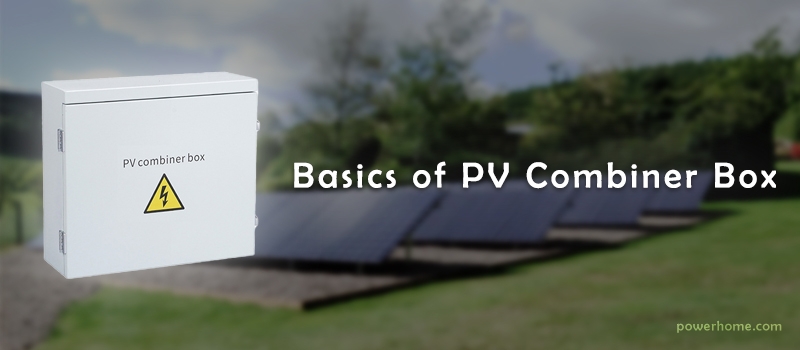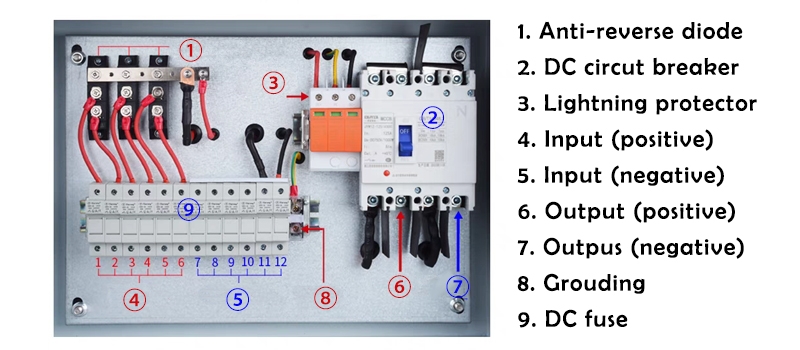Despite its unfamiliar name, the photovoltaic combiner box plays a vital role in the photovoltaic power generation system. A PV combiner box can also be called a solar combiner box, and as the name suggests, it is a device used to converge the current generated by the PV panels and to protect, monitor and control the current. This blog will bring you a basic introduction to the PV combiner box, including its definition, components and FAQs.
Basics of PV Combiner Box

Photovoltaic combiner box is an important equipment in the photovoltaic power generation system, mainly used for a certain number of solar cells with the same specifications are connected in series to form a photovoltaic series, and then a number of photovoltaic series are connected in parallel to the photovoltaic combiner box. In the combiner box, the output current of each PV series is gathered together and output through DC circuit breaker, which is used in conjunction with PV inverter, thus constituting a complete PV power generation system and realizing grid-connection with utility power.
In a photovoltaic power generation system, each photovoltaic panel generates a certain amount of current, which needs to be converged together to improve power generation efficiency. In addition, the combiner box can also protect the current, such as over-current protection, over-voltage protection, reverse protection, to ensure that the solar panels will not be damaged due to excessive current.
Photovoltaic combiner boxes are widely used in various PV systems, such as industrial and commercial photovoltaic power plants, distributed photovoltaic power plants, and rural household solar power plants.
Components of a PV Combiner Box
The components of PV convergence box include housing, DC circuit breaker, DC fuse, anti-reverse diode, data acquisition module, protection devices, human-machine interface, and other components that work together to ensure the normal operation and safety of PV power generation system. Choosing a PV converter box with better quality parts will reduce the burden of future repairs.

-
Housing: The housing is generally made of steel spraying, stainless steel, engineering plastics, etc. It is easy and convenient to install, and has the characteristics of high temperature resistance, corrosion resistance, dustproof and waterproof, which can meet the needs of the use of the complex environment in the outdoor.
-
DC Circuit Breaker: DC circuit breaker is the output control device of the whole solar combiner box, which is mainly used for circuit breaking/closing. As the solar energy generated by the solar module can be DC, easy to produce arc when the circuit breaks, therefore, in the selection of the full consideration of its temperature, altitude reduction coefficient, and be sure to choose the PV-specific DC circuit breakers.
-
DC Fuse: When current backflow occurs, the DC fuse quickly removes the faulty string from the system operation without affecting other normal working strings, which can safely protect the PV string and its conductors from the threat of reverse overload current.
-
Anti-reverse Diode: In the PV combiner box, the diode serves a different purpose than the diode in the module junction box. The diode in the component junction box is mainly to provide a continuation channel when the cell is blocked, while the diode in the convergence box is mainly to prevent loop current between strings.
-
Data Acquisition Module: The Data Acquisition Module is used to collect the operating data of the PV system, such as current, voltage, power and power generation. By monitoring the performance of the system in real time. The data acquisition module can help users understand the operating status of the system, identify potential problems in time, and optimize system performance.
-
Lightning Protector: To protect the system from lightning strikes and grid fluctuations, some PV combiner boxes are equipped with lightning protection devices.
FAQs about PV Combiner Box

Q: What is the difference between a PV combiner box and a PV inverter?
A: A PV converter box is mainly used to collect the output current from PV cells, while a PV inverter (including grid-connected or off-grid PV inverters) converts the DC power generated by PV cells into AC power for use by the load. Both play different roles in the PV power generation system and work together to ensure the stable operation of the PV power generation system.
Q: Do I need a combiner box for my home PV system?
A: When choosing a combiner box, the size of the system should be considered. For residential projects with only two or three strings, a combiner box may not be needed, while larger projects will require one. The choice of a combiner box should also take into account its functional requirements, such as whether it needs to be monitored and whether it supports a specific type of inverter, etc.
Q: Is there a requirement for the installation location of the PV combiner box?
A: The PV combiner box should be located between the solar modules and the inverter to reduce power loss and line resistance. Improve the overall efficiency and reliability of the PV system.
Q: How to choose the right converter box?
A: Ideally, a solar combiner box should be easy to deploy and install, and some offer plug-and-play solutions. The level of maintenance for a combiner box should be determined by the environment and frequency of use. It is a good idea to periodically check for leaks or loose connections. A properly installed photovoltaic combiner box can extend the life of your solar project.
PV combiner box plays a vital role as an important equipment in PV power generation system. By understanding the role, characteristics and common problems of the PV combiner box, you can better understand and apply this equipment, so that the PV power system can better power your off-grid home. In the context of the rapid development of the photovoltaic industry, the technology and application of photovoltaic combiner boxes will also continue to progress, bringing more possibilities to the field of photovoltaic power generation.
(1).png)
(1).png)